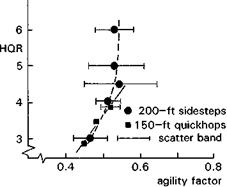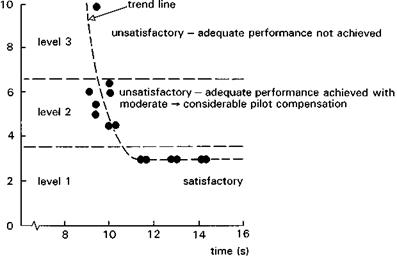In the early days of helicopter testing, these differences were often a surprise to the fixed-wing test pilots. Research into helicopter flying qualities at the Royal Aircraft Establishment goes back to the 1940s when engineers and pilots were getting to grips with the theory and practice respectively. In these early days of helicopter research, one of the key concerns was stability, or rather the lack of it. Stewart and Zbrozek (Ref. 2.31) describe a loss-of-control incident on an S-51 helicopter at RAE in 1948. Quoting from the pilot’s report in the reference:
When the observer said he was ready with his auto-observer, I pushed the stick forward about six inches and returned it quickly to its original position. The aircraft continued in straight and level flight for approximately three to five seconds before it slowly started a phugoid motion, with the nose dropping away slightly in the first instance. Each oscillation became greater, i. e. the dive and climb becoming steeper with every oscillation; it was accompanied by roll, at the bottom of the dive during the ‘pull-out’, it had maximum bank to the right.
The observer intimated recovery action to be taken at the end of the third oscillation; as the aircraft came over the top from the climb to go into the dive, I eased the stick forward to help it over the top. The stick felt light and there appeared to be no additional response from the aircraft; as the aircraft commenced diving again, I eased the stick back to where I considered I had pushed it from, thinking that I would let the speed build up somewhat before easing the stick further back to pull out of the dive. Quite a steep dive developed and just as I was about to ease the stick back, probably three seconds after the previous stick movement, there was suddenly severe vibration throughout what seemed to be the whole machine. From then on until recovery was effected (I estimate five to ten seconds later), I have no clear recollection of what took place. I think that immediately after the vibration, the aircraft flicked sharply to the left and nearly on to its back; it then fell more or less the right way up but the fuselage was spinning, I think, to the right. It fell into a steep dive and repeated the performance again; I selected autorotation quite early during the proceedings. Once I saw the rotor rpm at 140, and later at 250. There
|

Fig. 2.38 Fuselage failure on Sikorsky S-51 (Ref. 2.31)
|
were moments when the stick was very light and others when it was extremely heavy.
The machine, I think, did three of these manoeuvres; it seemed to want to recover during the second dive but it actually responded to the controls during the third dive. Height when straight and level was 400feet above sea level (height loss 800feet).
The aircraft responded normally to the controls when under control again; I flew back to the airfield and landed.
The pilot had excited the phugoid mode with a longitudinal cyclic pulse; recovery action was initiated at the end of the third oscillation, the aircraft increased speed in a dive and during the pull-out the blades hit the droop stop, and eventually the fuselage, causing a rapid uncontrollable rolling motion. The resulting erratic motions, during which the pilot became disoriented, eventually settled down and the aircraft was flown back to RAE and landed safely. The ‘auto-observer’ recorded a peak normal acceleration of more than 4 g during the manoeuvre, causing severe buckling to occur in the rear fuselage (Fig. 2.38). Two of the conclusions of the analysis of this incident were
(1) ‘… large rapid movements of the controls are to be avoided, particularly at high speed’.
(2) ‘some form of flight testing technique should be devised whereby the susceptibility of a helicopter to this trouble should be ascertained in the prototype stage’.
These conclusions are as relevant today as they were in the early days of helicopter flight testing; the ‘trouble’ noted above is still a feature of unaugmented helicopters. Today, however, there exist flying qualities criteria that define the boundaries of
|

Fig. 2.39 Long period pitch stability characteristics
|
acceptable mid-term pitch characteristics. Figure 2.39 illustrates the frequency/ damping requirements set down in ADS-33; the Level 1/2 and 2/3 boundaries are shown for both helicopters and fixed-wing aircraft (Ref. 2.3) for ‘fully attended’ flight. Also included are the loci of characteristics for the two baseline simulation configurations, Helisim Lynx and Helisim Puma, in bare airframe or unstabilized configurations. Several points can be drawn out of this figure. First, there is a range where characteristics that are acceptable as Level 1 for helicopters are classified as Level 3 for fixed-wing aircraft. Secondly, for most of their flight envelopes, our two Helisim aircraft will not even meet the Level 3 requirements of the fixed-wing criteria. The fact is that it is impossible to build helicopters that, without augmentation, meet the fixed-wing standards; earlier in this chapter we discussed one of the reasons for this concerning the positive stability derivative Mw. But this is not a good reason for degrading the boundaries for safe flight. On the contrary, the boundaries in Fig. 2.39 are defined by flight results, which implies that rotary-wing pilots are willing to accept much less
Pilot can devote full attention to attitude and flight path control.
than their fixed-wing counterparts. Hoh, in Ref. 2.4, has suggested two reasons for this:
(1) ‘helicopter pilots are trained to cope with, and expect as normal, severe instabilities and cross-axis coupling;’ and
(2) ‘the tasks used in the evaluations were not particularly demanding’.
The two reasons go together and helicopters could not be used safely for anything but gentle tasks in benign conditions until feedback autostabilization could be designed and built to suppress the naturally divergent tendencies.
Included in Fig. 2.39 is the helicopter boundary for ‘divided attention’ operations; this eliminates all unstable machines by requiring a damping ratio of 0.35. Thus, helicopters that need to operate in poor weather or where the pilot has to release the controls, or divert his attention to carry out a secondary task, need some form of artificial stabilization. This conclusion applies to both military and civil operations, the increased emphasis on safety for the latter providing an interesting counterpoint; criteria for civil helicopter flying qualities will be discussed further in Chapter 6.
The S-51 incident described above illustrates two important consequences of flying qualities deficiencies – that pilot disorientation and aircraft strength are the limiting factors, i. e., the things that eventually ‘give’, and can therefore terminate the situation following loss of control. This is the key to understanding that good flying qualities are ‘mission critical’.






















